
Wine Culture and Information since 2002 - Volume 22
 Wine Culture and Information since 2002 - Volume 22 |
|
Issue 153, Summer 2016 |
Contents |
|
|
2016: The Coming Grape |
|
In the past recent years, at least in Italy, it seems the old Italian saying “the seasons of the past are gone forever” is quite appropriate to the meteorological condition of the country. By considering the bizarre springtime we had this year, it seems we are living in a tropical country instead of Italy. Let's hope summer will be more clement and may give a more regular and coherent season. In case it should repeat what happened in springtime, vintners and farmers will have more than one reason to be concerned of. Rains and storms have characterized most of springtime, with temperature ranging from cold to humid heat. By still considering the old wisdom of our Country, it seems we can certainly say “springtime and autumn are not what they used to be”. Meteorologists said that, by considering the quantity of water of springtime's rains, this seems to be normal. The point, however, is the concentration and the intensity of rains which looked like flooding instead of springtime rains. Temperature has been as much bizarre as the rain. In particular in April, in that period in which vines start budding and resume their vegetative activity. In certain areas of Italy - as well as in some parts of Europe - there have been frosts which damaged vineyards. In Burgundy and Loire, in particular, last April's frost has literally burnt buds of vines which were about to become grapes. This means that, in the areas affected by this frost, it will be likely the vegetative activity will delay as plants will have to bear new buds, in case they are in the proper condition to do so. In these areas, unavoidably, harvesting will be delayed in order to let the new buds to come to full ripeness, in case summer and autumn meteorological conditions will be favorable. Italy too has been affected by the unexpected cold temperature in April and the regions to have complained the worst damages in vineyards have been Abruzzo and Molise. In some cases, vintners have declared that, because of the damages in their vineyards, it is likely that, for them, vintage 2016 will be quite limited. It is not over, of course. Summer is about to come and, provided it will not follow the bizarre springtime weather, there is still good hope and possibility to recover. Every farmer and vintner know one must always look at the sky. Not for praising a divine intervention, indeed to prevent the effects of weather. This is of course possible in case of “benevolent” and controllable meteorological events, of course not in case of very bad and devastating events, such as hail and, of course, frosts. The abundant rains in springtime have forced vintners to properly take measures against downy mildew and powdery mildew. These two diseases are in fact particularly active from the second half of springtime to the first part of summer, when grape bunches start to develop. Prevention measures against these two diseases consist in applying copper sulfate for downy mildew and sulfur for powdery mildew. The use of these two substances is by many considered as traditional - therefore acceptable - while noticing there also are other remedies considered by others less harmful for the environment. We should in fact consider despite copper sulfate is an effective remedy against downy mildew, it is however a heavy metal and when applied to a vineyard it is absorbed by the soil as well. Rain, fog and wide temperature changes are the cause of humidity and therefore mold. To tell the truth, it is too early to be concerned about mold, however it can be something to cause problems when bunches are fully developed and are about to get to full ripeness. In case summer would be bizarre like springtime, mold will unavoidably be a serious risk for harvesting, in particular in September. It should be noticed the presence of mold, when it gets developed in particular conditions, is always welcome in vineyards of those producers who make the so called “botrytized wines”, while it is a curse for the rest. It should also be noticed not all grapes are affected the same by the mold, as in those having a thick skin the effects are vain and negligible. The same cannot be said for those varieties having a thin skin, such as the many grapes belonging to the numerous family of Malvasie, widely found in Italy. We only need to be confident about summer to be coherent with its nature because we have already seen rains and cold temperatures quite a lot in this springtime. Vines certainly have huge water reserve in the deep from which roots can benefit from. This means - in case summer will be sultry and dry - roots can take water from the deep of soil. The abundant springtime rains, as well as low temperatures, will certainly play a role in the vegetative cycle of vines and would determine a delay in ripeness of grapes and therefore harvesting. We need to hope for a regular summer and not so bizarre like springtime while wishing 2016 may give us excellent wines. My thoughts, I admit it, are with all the vintners who, understandably, this summer will continue looking at the sky, wishing themselves to harvest extraordinary grapes and then to give us, once again, amazing emotions with their wines. Antonello Biancalana
|
||||
Contrasts of Corvina and MarzeminoTwo bordering regions which frequently proved to make magnificent wines, Veneto and Trentino are the homelands of the two grapes of our tasting by contrast |
|
This month we are going to pour in our glasses red wines and we do that with two varieties playing a very important role in their respective regions. We are in fact going to talk about Corvina and Marzemino, respectively protagonists of the wine and viticultural scene of Veneto and Trentino. Corvina is the most representative grape in Valpolicella and Bardolino wines, a variety also used for the renowned Amarone and Recioto della Valpolicella. Marzemino, undoubtedly, is not as famous as Corvina, however it is capable of making interesting wines, also benefiting from a glorious past which made this grape famous outside its land. Two grapes, however, very different one from each other and having no connection, despite the relatively short distance dividing the two areas in which they are cultivated. A distance which can be found, in particular, in wines made from these two varieties. Corvina is mostly cultivated in the vast territory of Valpolicella and it is virtually found in Veneto only, with marginal and rare exceptions outside this region. Marzemino is found in many areas of Northern Italy and, despite it is strongly associated to Trentino, it is also used for the production of wines in other regions in Italy. On this regard, are mentioned the DOC areas in Lombardy of Garda - extending to the neighboring Veneto - Botticino, Cellatica, Capriano del Colle and Riviera del Garda Bresciano. In Veneto is also found in the DOC areas of Breganze and Merlara, in Reggio Emilia is a grape used for the DOC wines of Colli di Scandiano e Canossa. Both varieties are used for the production of many styles and - in this sense - Marzemino certainly is more versatile, as it is sometimes used for the production of sparkling wines as well.
|
|
Talking about Corvina it is impossible not to mention the most famous wine produced with this grape: Amarone della Valpolicella. Indeed, Corvina is also used in other wines of Veneto and it is used, among the many, in Valpolicella, Bardolino and Garda reds, as well as Recioto della Valpolicella. The interest for Corvina - certainly supported by the fame of Amarone and Valpolicella wines - reached, with a quite interesting success, vineyards of other countries of the world as well. Generally used blended to other varieties - in particular Rondinella, Molinara and Corvinone - Corvina is capable of making interesting wines also in case it is used alone. A choice, to tell the truth, few producers made, probably attracted by the commercial advantage the Valpolicella name can ensure in sales. The origins of Corvina are quite uncertain, it is however believed it originated from the territory of Verona. Historical mentions about Corvina - which complete name is Corvina Veronese - are in fact rare and sometimes obscure, therefore the determination of its origin is quite difficult. Corvina has also been subject of confusion, in particular with Corvinone grape, considered for a very long time one of its clones. Indeed, they are two distinct grapes having no connection and they are more and more used together for the production of Valpolicella wines. Corvina, when used alone, is capable of giving elegant and pleasing wines, thanks to its characteristics it can be vinified both in inert and wood containers. On this regard, the tasting of wines made from 100% Corvina have a totally different nature from the more robust personality of Amarone, in which this grape is used in significant quantity.
|
||||
|
Marzemino is one of the most famous red berried grapes of Trentino and it is used for the production of agreeable wines and of interesting wine quality. This renowned variety - today mainly identified with Trentino - has a glorious past and its wines were found and well appreciated in the tables of wealthy people of Europe. Because of its notoriety, as well as the evident quality of its wines, it was mentioned in Wolfgang Amadeus Mozart's opera Don Giovanni whom it is said to have a particular predilection for this wine. It is in fact said the young Mozart, in occasion of his trips to Trentino, had the chance to know and appreciate Marzemino. It is in fact famous the scene in which Don Giovanni - in the libretto of Lorenzo Da Ponte - orders his servant Leporello “Versa il vino. Eccellente Marzimino!” (Pour the wine. Excellent Marzimino!). This also proves the notoriety of this wine at those times and it is a well known fact it was particularly appreciated in the tables of Austrian nobles. About the origins of Marzemino we have reliable information, despite the confusion of the past times, and today it is commonly believed this grape comes from Lesser Asia. It is in fact believed Marzemino originates from Merzifon - a city of Turkey, in the coasts of Black Sea - it arrived in Veneto, it then spread to Lombardy and Trentino. It is in this latter region Marzemino found its best expression, in particular in Vallagarina in the Isera and Volano areas. It should however be noticed this grape is also found in other areas in Italy and it is used in many DOC wines of Lombardy, Veneto and Emilia Romagna. Marzemino makes wines of remarkable agreeableness also thanks to its exuberant aromatic profile and, last but not the least, an elegant astringency well balanced by alcohol. For this reason producers usually make Marzemino wines destined to an immediate consumption and it is widely believed its wines do not have a long aging potential. Indeed, when it is made with this explicit goal, Marzemino is capable of making wines having the potential of aging and improving for many years.
|
|
For our tasting by contrast we will choose two bottles respectively produced with 100% Corvina and Marzemino. Choosing a Marzemino wine is relatively easy as this grape is frequently vinified alone, although it is also blended to other varieties, in particular in Lombardy. Choosing Corvina is somewhat harder because this grape is rarely vinified alone and it is something few producers make. We will however choose a wine made of 100% Corvina, coming from the Verona area and aged in inert containers in order to favor the appreciation of its sensorial qualities. The Marzemino of our tasting too will be vinified in inert containers - a technique widely used with this grape - and we will choose a bottle coming from the Isera area. Both wines must be aged not more than two years and will be tasted at the temperature of 17 °C. (63 °F)
Our tasting by contrast begins, as usual, from the analysis of appearance of two wines, that is how they show themselves on the glass. The first wine we will analyze is Corvina. Let's tilt the glass over a white surface and observe the base of the wine: here we will see an intense and brilliant ruby red color with a moderate transparency. Nuances of Corvina - observed at the edge of wine, towards the opening of the glass - show a ruby red color and, sometimes, with garnet red hues. Let's now pass to the evaluation of Marzemino. The base of the glass offers to the sight of taster an intense ruby red color, almost deep, clearly deeper than Corvina. Transparency of Marzemino is evidently lower than the first wine. Nuances usually show a color having purple red hue, perfectly mixed to ruby red. Aromas expressed by Corvina and Marzemino directly recall black and red fruits, although with evident differences. Corvina, like to say, expresses rounder and warmer sensations than Marzemino which, sometimes, gives a crisper and fresher olfactory profile. Aromas perceived in Corvina recall black cherry, blackberry and plum, frequently giving the sensation of ripe fruits. Like already said, Marzemino cultivated in Vallagarina gives the nose fruit sensations that, compared to Corvina, seem to have a fresher and crisper profile. To the nose are perceived aromas of cherry, plum, raspberry, blueberry and, frequently, pleasing aromas of almond. Among aromas recalling sensations associated to the world of flowers, in Marzemino is mainly perceived violet. Let's now proceed with the olfactory evaluation of both wines from the one produced with Corvina. Let's hold the glass in vertical position and, without swirling, do the first smell, an operation allowing the appreciation of wine's opening. From the glass will be perceived intense and clean aromas of black cherry, plum and blackberry to which follow, soon after, the aroma of violet. Swirl the glass now, in order to favor the oxygenation of wine, then do a second smell. From the glass will be perceived aromas of blueberry, raspberry and, sometimes, rose. Let's now pass to the glass of Marzemino and evaluate its opening. The nose will perceive aromas of cherry, plum and blueberry, followed by pleasing hints of violet and almond. After having swirled the glass, the olfactory profile of Marzemino is completed by raspberry, blackberry, pomegranate, cyclamen and, sometimes, geranium. It should be compared the olfactory impact of the two wines: Marzemino has an evidently fresher and crisper character than Corvina. Sensorial differences of the two wines are also perceived during the gustatory analysis. Let's take a sip of Corvina and concentrate on the sensations produced by the attack, that is the initial perception we get in the mouth. The sensation expressed by this wine is characterized by a moderate astringency and balance is promptly reached by the evident roundness, to which is added the contribution of alcohol. In the mouth are perceived flavors of black cherry, plum and blackberry, confirming a good correspondence to the nose. Let's now taste Marzemino. The attack of this wine gives the mouth a fresher and more acidic sensation than Corvina, with a moderate astringency. In this wine it is in fact crispness to dominate the gustatory profile, in which are perceived flavors of cherry, plum and blueberry, with a good correspondence to the nose. The final phase of our tasting by contrast will continue putting in evidence the differences between the two wines. The finish of Corvina - that is the sensation perceived in the mouth after having swallowed the wine - is characterized by a good persistence in which is still perceived the round character of the wine. In the mouth are also perceived flavors of black cherry, plum and blackberry. The finish of Marzemino is characterized by a good persistence, leaving in the mouth flavors of cherry, plum and blueberry, as well as the characteristic almond flavor, typical in wines produced with this variety. The overall sensation left in the mouth is dominated by a good crispness, just like in the previous phase, characterized by a pleasing acidity. Two grapes evidently interesting and having a remarkable personality, Corvina and Marzemino offer to the senses of the taster evident differences, even distant, however capable of making wines of refined agreeableness.
|
||||||||
Wines of the Month |
|
|
|
Score legend Prices are to be considered as indicative. Prices may vary according to the country or the shop where wines are bought |
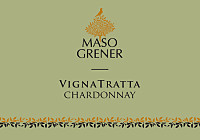
|
|
Trentino Chardonnay Vigna Tratta 2013 |
|
| Maso Grener (Trentino, Italy) | |
 Chardonnay Chardonnay | |
| Price: € 12.50 | Score: |
 Brilliant straw yellow and nuances of straw yellow, very transparent. Brilliant straw yellow and nuances of straw yellow, very transparent. Intense, clean, pleasing and refined, starts with hints of apple,
citrus fruits and banana followed by aromas of ripe pear, plum, hawthorn,
flint, acacia and pineapple. Intense, clean, pleasing and refined, starts with hints of apple,
citrus fruits and banana followed by aromas of ripe pear, plum, hawthorn,
flint, acacia and pineapple.
 Crisp attack and however balanced by alcohol, good body, intense
flavors, pleasing roundness. Crisp attack and however balanced by alcohol, good body, intense
flavors, pleasing roundness.
 Persistent finish with flavors of apple, banana and plum. Persistent finish with flavors of apple, banana and plum. Aged in steel tanks. Aged in steel tanks. |
|
 Stuffed pasta with fish, Stewed fish, Sauteed white meat, Mushroom soups Stuffed pasta with fish, Stewed fish, Sauteed white meat, Mushroom soups |
|
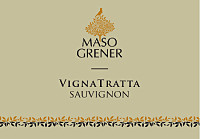
|
|
Trentino Sauvignon VignaTratta 2013 |
|
| Maso Grener (Trentino, Italy) | |
 Sauvignon Blanc Sauvignon Blanc | |
| Price: € 12.50 | Score: |
 Pale straw yellow and nuances of greenish yellow, very transparent. Pale straw yellow and nuances of greenish yellow, very transparent. Intense, clean, pleasing and refined, starts with hints of gooseberry,
elder flower and plum followed by aromas of pear, peach, apple, nettle,
broom, pineapple and mineral. Intense, clean, pleasing and refined, starts with hints of gooseberry,
elder flower and plum followed by aromas of pear, peach, apple, nettle,
broom, pineapple and mineral.
 Crisp attack and however balanced by alcohol, good body, intense
flavors, pleasing roundness. Crisp attack and however balanced by alcohol, good body, intense
flavors, pleasing roundness.
 Persistent finish with flavors of gooseberry, peach and plum. Persistent finish with flavors of gooseberry, peach and plum. Aged in steel tanks. Aged in steel tanks. |
|
 Pasta and risotto with crustaceans and vegetables, Sauteed crustaceans, Mushroom soups Pasta and risotto with crustaceans and vegetables, Sauteed crustaceans, Mushroom soups |
|
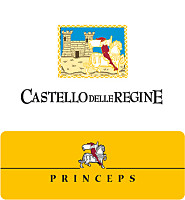
|
|
Princeps 2005 |
|
| Castello delle Regine (Umbria, Italy) | |
 Cabernet Sauvignon (60%), Sangiovese (20%), Merlot (20%) Cabernet Sauvignon (60%), Sangiovese (20%), Merlot (20%) | |
| Price: € 20.00 | Score: |
 Intense ruby red and nuances of brick red, little transparency. Intense ruby red and nuances of brick red, little transparency. Intense, clean, pleasing and refined, starts with hints of prune, black
currant and dried violet followed by aromas of black cherry jam, blueberry
jam, vanilla, leather, tobacco, licorice, cocoa and eucalyptus. Intense, clean, pleasing and refined, starts with hints of prune, black
currant and dried violet followed by aromas of black cherry jam, blueberry
jam, vanilla, leather, tobacco, licorice, cocoa and eucalyptus.
 Properly tannic attack and however balanced by alcohol, good body,
intense flavors, pleasing roundness. Properly tannic attack and however balanced by alcohol, good body,
intense flavors, pleasing roundness.
 Persistent finish with flavors of prune, blueberry jam and black cherry
jam. Persistent finish with flavors of prune, blueberry jam and black cherry
jam.
 More than 24 months in barrique and bottle. More than 24 months in barrique and bottle. |
|
 Roasted meat, Braised and stewed meat with mushrooms, Hard cheese Roasted meat, Braised and stewed meat with mushrooms, Hard cheese |
|
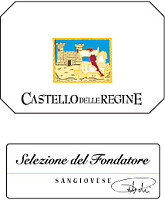
|
|
Selezione del Fondatore 2005 |
|
| Castello delle Regine (Umbria, Italy) | |
 Sangiovese Grosso Sangiovese Grosso | |
| Price: € 28.00 | Score: |
 Intense ruby red and nuances of brisk red, little transparency. Intense ruby red and nuances of brisk red, little transparency. Intense, clean, pleasing, refined and elegant, starts with hints of
prune, black cherry and dried violet followed by aromas of blueberry,
vanilla, cocoa, licorice, leather, coffee, cinnamon, mace, tobacco and
menthol. Intense, clean, pleasing, refined and elegant, starts with hints of
prune, black cherry and dried violet followed by aromas of blueberry,
vanilla, cocoa, licorice, leather, coffee, cinnamon, mace, tobacco and
menthol.
 Properly tannic attack and however balanced by alcohol, full body,
intense flavors, pleasing roundness. Properly tannic attack and however balanced by alcohol, full body,
intense flavors, pleasing roundness.
 Persistent finish with flavors of plum, black cherry and blueberry. Persistent finish with flavors of plum, black cherry and blueberry. 14 months in barrique, at least 36 months in bottle. 14 months in barrique, at least 36 months in bottle. |
|
 Game, Roasted meat, Braised and stewed meat, Hard cheese Game, Roasted meat, Braised and stewed meat, Hard cheese |
|
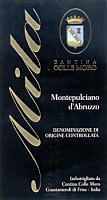
|
|
Montepulciano d'Abruzzo Mila 2011 |
|
| Colle Moro (Abruzzo, Italy) | |
 Montepulciano Montepulciano | |
| Price: € 4.70 | Score: |
 Intense ruby red and nuances of garnet red, little transparency. Intense ruby red and nuances of garnet red, little transparency. Intense, clean, pleasing and refined, starts with hints of plum, black
cherry and blackberry followed by aromas of dried violet, blueberry,
vanilla, tobacco, chocolate and carob. Intense, clean, pleasing and refined, starts with hints of plum, black
cherry and blackberry followed by aromas of dried violet, blueberry,
vanilla, tobacco, chocolate and carob.
 Properly tannic attack and however balanced by alcohol, good body,
intense flavors, agreeable. Properly tannic attack and however balanced by alcohol, good body,
intense flavors, agreeable.
 Persistent finish with flavors of plum, black cherry and blackberry. Persistent finish with flavors of plum, black cherry and blackberry. 12 months in barrique. 12 months in barrique. |
|
 Broiled meat and barbecue, Roasted meat, Stewed meat, Hard cheese Broiled meat and barbecue, Roasted meat, Stewed meat, Hard cheese |
|

|
|
Montepulciano d'Abruzzo Alcàde 2010 |
|
| Colle Moro (Abruzzo, Italy) | |
 Montepulciano Montepulciano | |
| Price: € 7.00 | Score: |
 Brilliant ruby red and nuances of ruby red, little transparency. Brilliant ruby red and nuances of ruby red, little transparency. Intense, clean, pleasing and refined, starts with hints of black
cherry, plum and blueberry followed by aromas of violet, blackberry,
vanilla, pomegranate, tobacco, carob, chocolate and menthol. Intense, clean, pleasing and refined, starts with hints of black
cherry, plum and blueberry followed by aromas of violet, blackberry,
vanilla, pomegranate, tobacco, carob, chocolate and menthol.
 Properly tannic attack and however balanced by alcohol, good body,
intense flavors, agreeable. Properly tannic attack and however balanced by alcohol, good body,
intense flavors, agreeable.
 Persistent finish with flavors of black cherry, plum and blueberry. Persistent finish with flavors of black cherry, plum and blueberry. Aged in barrique. Aged in barrique. |
|
 Broiled meat and barbecue, Stewed meat with mushrooms, Roasted meat, Hard cheese Broiled meat and barbecue, Stewed meat with mushrooms, Roasted meat, Hard cheese |
|
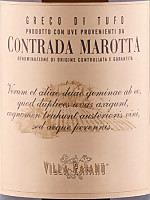
|
|
Greco di Tufo Contrada Marotta 2013 |
|
| Villa Raiano (Campania, Italy) | |
 Greco Bianco Greco Bianco | |
| Price: € 18.00 | Score: |
 Brilliant golden yellow and nuances of straw yellow, very transparent. Brilliant golden yellow and nuances of straw yellow, very transparent. Intense, clean, pleasing, refined and elegant, starts with hints of
peach, quince and medlar followed by aromas of citrus fruits, pear,
hawthorn, linden flower, broom, plum, almond and mineral. Intense, clean, pleasing, refined and elegant, starts with hints of
peach, quince and medlar followed by aromas of citrus fruits, pear,
hawthorn, linden flower, broom, plum, almond and mineral.
 Crisp attack and however balanced by alcohol, good body, intense
flavors, pleasing roundness. Crisp attack and however balanced by alcohol, good body, intense
flavors, pleasing roundness.
 Persistent finish with flavors of quince, peach and medlar. Persistent finish with flavors of quince, peach and medlar. 10 months in steel tanks, 14 months in bottle. 10 months in steel tanks, 14 months in bottle. |
|
 Stuffed pasta, Roasted fish, Roasted white meat, Mushroom soups Stuffed pasta, Roasted fish, Roasted white meat, Mushroom soups |
|
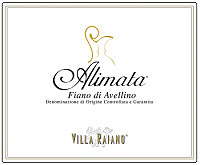
|
|
Fiano di Avellino Alimata 2013 |
|
| Villa Raiano (Campania, Italy) | |
 Fiano Fiano | |
| Price: € 18.00 | Score: |
 Brilliant straw yellow and nuances of greenish yellow, very
transparent. Brilliant straw yellow and nuances of greenish yellow, very
transparent.
 Intense, clean, pleasing, refined and elegant, starts with hints of
apple, medlar and hawthorn followed by aromas of pear, peach, plum, citrus
fruits, pineapple, broom, hazelnut, juniper, rosemary and mineral. Intense, clean, pleasing, refined and elegant, starts with hints of
apple, medlar and hawthorn followed by aromas of pear, peach, plum, citrus
fruits, pineapple, broom, hazelnut, juniper, rosemary and mineral.
 Crisp attack and however balanced by alcohol, good body, intense
flavors, agreeable. Crisp attack and however balanced by alcohol, good body, intense
flavors, agreeable.
 Very persistent finish with long flavors of apple, plum and medlar. Very persistent finish with long flavors of apple, plum and medlar. 10 months in steel tanks, 14 months in bottle. 10 months in steel tanks, 14 months in bottle. |
|
 Pasta with fish and crustaceans, Stewed fish, Roasted white meat Pasta with fish and crustaceans, Stewed fish, Roasted white meat |
|
News |
|
In this section are published news and information about events concerning the world of wine and food. Whoever is interested in publishing this kind of information can send us a mail to our address.
|
AquavitaeReview of Grappa, Distillates and Brandy |
|
|
||||||||||||||
Wine Guide ParadeApril 2016
|
| |||||||
Privacy Policy | |||||||


| Copyright © 2002-2024 Antonello Biancalana, DiWineTaste - All rights reserved |
| All rights reserved under international copyright conventions. No part of this publication and of this WEB site may be
reproduced or utilized in any form or by any means, electronic or mechanical, without permission in writing from DiWineTaste. |